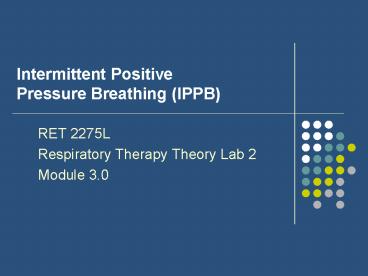Intermittent Positive Pressure Breathing (IPPB) - PowerPoint PPT Presentation
1 / 38
Title:
Intermittent Positive Pressure Breathing (IPPB)
Description:
Title: Intermittent Positive Pressure Breathing (IPPB) Author: Phillip D. Slocum Created Date: 2/15/2005 8:15:32 AM Document presentation format – PowerPoint PPT presentation
Number of Views:270
Avg rating:3.0/5.0
Title: Intermittent Positive Pressure Breathing (IPPB)
1
Intermittent Positive Pressure Breathing (IPPB)
- RET 2275L
- Respiratory Therapy Theory Lab 2
- Module 3.0
2
IPPB
- Definition
- The application of inspiratory positive pressure
to a spontaneously breathing patient as an
intermittent or short-term therapeutic modality
3
IPPB
- Definition
- The delivery of a slow deep sustained inspiration
by a mechanical device providing controlled
positive pressure breath during inspiration
4
IPPB
- Indications (AARC)
- The need to improve lung expansion
- Treatment of atelectasis not responsive to other
therapies, (e.g., IS and CPT) - Inability to clear secretions adequately
- Limited ventilation
- Ineffective cough
5
IPPB
- Indications (AARC)
- Short-term nonivasive ventilatory support for
hypercapnic patients - Alternative to intubation and continuous
ventilatory support
6
IPPB
- Indications (AARC)
- The need to deliver aerosol medication
- When MDI or nebulizer has been unsuccessful
- Patients with ventilatory muscle weakness or
fatigue
7
IPPB
- Contraindications (AARC)
- Tension pneumothorax
- ________________________________________
- ICP gt 15 mm Hg
- Hemodynamic instability
- Recent facial, oral or skull surgery
8
IPPB
- Contraindications (AARC)
- Tracheoesophageal fistula
- Recent esophageal surgery
- Active hemoptysis
- Nausea
- Air swallowing
9
IPPB
- Contraindications (AARC)
- Active, untreated TB
- Radiographic evidence of bleb
- Singulus (hiccups)
10
IPPB
- Hazards (AARC)
- Increase airway resistance (Raw)
- Barotrauma, pneumothorax
- Nosocomial infection
- Hyperventilation (hypocapnia)
- Hemoptysis
11
IPPB
- Hazards (AARC)
- Hyperoxia when O2 is the gas source
- Gastric distention
- Secretion impaction (inadequate humidity)
- Psychological dependence
- Impedance of venous return
12
IPPB
- Hazards (AARC)
- Exacerbation of hypoxemia
- Hypoventilation
- Increased V/Q mismatch
- Air trapping, auto peep, overdistended alveoli
13
IPPB
- Potential Outcomes
- Improved IC or VC
- Increased FEV1 or peak flow
- Enhanced cough or secretion clearance
- Improved Chest radiograph
- Improved breath sounds
14
IPPB
- Potential Outcomes
- Improved oxygenation
- Favorable patient subjective response
15
IPPB
- Baseline Assessment
- Vital signs
- Patients appearance and sensorium
- Breathing pattern
- Breath sounds
16
IPPB
- Implementation
- Infection control
- Equipment preparation
- Pressure check machine/circuit
- Patient orientation
- Why MD ordered therapy
- What treatment does
- How it feels
- Expected results
17
IPPB
- Implementation
- Application
- Mouthpiece / nose clip (initially)
- Mouthseal
- Mask
- Trach adaptor
18
IPPB
- Implementation
- Machine settings
- Sensitivity of 1 2 cm H2O
- Initial pressure between 10 15 cm H20
- Breathing pattern of 6 breaths/min
- IE ration of 13 to 14
- Flow and pressure will need subsequent adjustment
to patients needs and goal
19
IPPB
- Implementation
- When treating atelectasis
- Therapy should be volume-oriented
- Tidal volumes (VT) must be measured
- VT goals must be set
- VT goal of 10 15 mL/kg of body weight
- Pressure can be increased to reach VT goal if
tolerated by patient
20
IPPB
- Implementation
- When treating atelectasis
- IPPB is only useful in the treatment of
atelectasis if the volumes delivered exceeds
those volumes achieved by the patients
spontaneous efforts
21
IPPB
- Discontinuation and Follow-Up
- Treatments typically last 15-20 minutes
- Repeat patient assessment
- Identify untoward effects
- Evaluate progress
- Document
22
IPPB
- Next Week?
23
La Maquina !
24
IPPB Bird Series
- Mark 7 Series
- Pneumatically driven
- Can be time, pressure, or manually TRIGGERED
- Pressure CYCLED
- Can be used to provide short-term ventilatory
support - Primarily used for IPPB therapy
25
IPPB Bird Series
Inspiratory Flow Rate
Sensitivity Control
Pressure Control
Air Dilution
Expiratory Timer
26
IPPB Bird Series
Center Body
Gas Source Inlet
Ambient Chamber
Pressure Chamber
Mainstream Hose Connection
Hand Timer
Nebulizer / Exhalation Valve Connection
Pressure Manometer
27
IPPB Bird Circuit
Holder
Nebulizer/Exhalation Valve Drive Line
Exhalation Valve Drive Line
Reservoir Tube
Mouthpiece
Exhalation Valve
Main Flow Tube
Nebulizer
Manifold
28
IPPB Bird Circuit
- Inhalation
29
IPPB Bird Circuit
- Exhalation
30
IPPB Puritan Bennett PR Series
- PR-1 PR-2
31
IPPB Puritan Bennett PR Series
- PR-1 and PR-2
- Pneumatically driven
- Can be time, pressure, or manually TRIGGERED
- Flow CYCLED, pressure limited
- Can be used to provide short-term ventilatory
support - Primarily used for IPPB therapy
32
IPPB Puritan Bennett PR Series
33
IPPB PR - 1 Controls / Parts
Control Pressure Manometer
System Pressure Manometer
Sensitivity
Hook
Rate
Pressure
Gas Source Inlet
Filter
Air Dilution
Inspiratory Nebulization
Bennett Valve
Continuous Nebulization
Main Flow Connection
Nebulizer Connection
Expiratory Valve Connection
34
IPPB PR - 1 Controls / Parts
Handout
35
IPPB PR - 2 Controls / Parts
Control Pressure Manometer
System Pressure Manometer
Terminal Flow
Sensitivity
Expiratory Timer
Hook
Rate
Pressure
Gas Source Inlet
Filter
Air Dilution
Negative Pressure
Negative Pressure Connection
Inspiratory Nebulization
Bennett Valve
Continuous Nebulization
Main Flow Connection
Nebulizer Connection
Expiratory Valve Connection
Peak Flow
36
IPPB PR - 2 Controls / Parts
Handout
37
IPPB Puritan Bennett AP Series
- Electrically Powered
- Pressure limited
- Only patient triggered
AP- 4 AP - 5
38
IPPB Puritan Bennett Circuit































